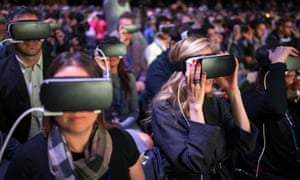#43 Facebook sets up 'social VR' team to
explore virtual reality beyond games
Facebook has created a “social VR” team to explore
virtual-reality technology’s potential beyond games, as it prepares for the
consumer launch of its Oculus Rift VR headset.Chief executive Mark Zuckerberg
revealed the plans in a surprise appearance at Samsung’s Mobile World Congress
press conference, while talking up the popularity of 360-degree videos on
Facebook, and on Samsung’s Gear VR headset – which uses technology from
Oculus.“People have already watched more than a million hours of video in Gear
VR,”explained a blog post from Facebook following the event. “Already, millions
of people watch 360 videos on Facebook every day. More than 20,000 have been
uploaded, with hundreds more added daily.”Facebook is upping the quality of
360-degree videos on its service, while tasking its new team with developing
other kinds of non-games content for VR headsets.
- Virtual reality is already one of the hot topics at this year’s Mobile World Congress conference.
- HTC has confirmed that its Vive headset will cost $799, with pre-orders opening at the end of February. Meanwhile, LG is launching its own headset, designed to work with its new G5 Android smartphone.
#44 Mobile
operator Three to introduce adblocking
Mobile company Three is to introduce adblocking across its
UK and Italian networks, making it the first major European operator to do so. Three
has struck a deal with Israeli company Shine that will see the mobile
adblocking technology introduced in the UK and Italy, followed by a “rapid
roll-out” across its operations in other countries. The move is cause for
serious concern for digital publishers and advertisers, which are already
dealing with a rising number of people who block advertising when they use
their phones. Three said its move to implement network-wide adblocking is not
an attempt to “eliminate” all mobile advertising, but to “give customers more
control, choice and greater transparency over what they receive”. The company,
which has 9 million UK customers, said a network-wide adblocking strategy is
better than relying on apps because it “reaches a broader range of mobile
adblocking”.
- Customers pay data charges so they should not then receive ads, costs which the company says advertisers should be made to pay.
- Some advertising aims to elicit customer data and information without them knowing.
- Customers should only receive relevant advertising and not have their mobile experience “degraded by excessive, intrusive, unwanted or irrelevant ads”





